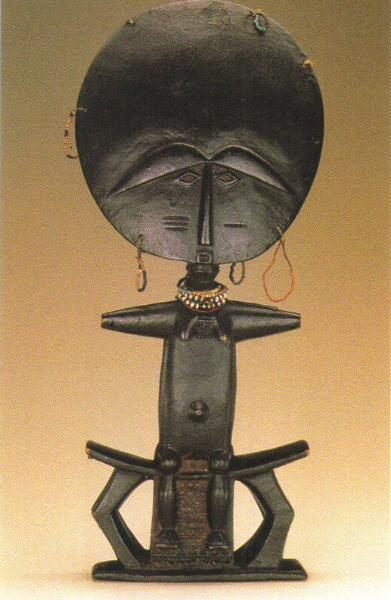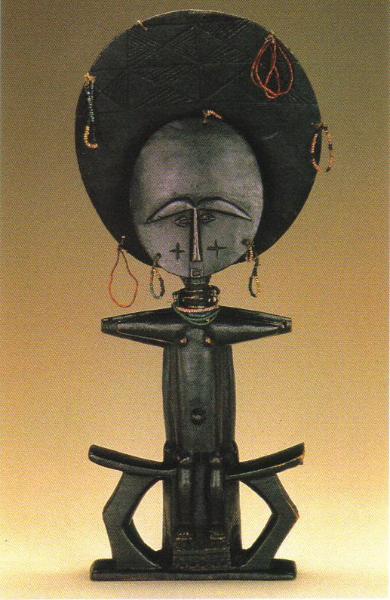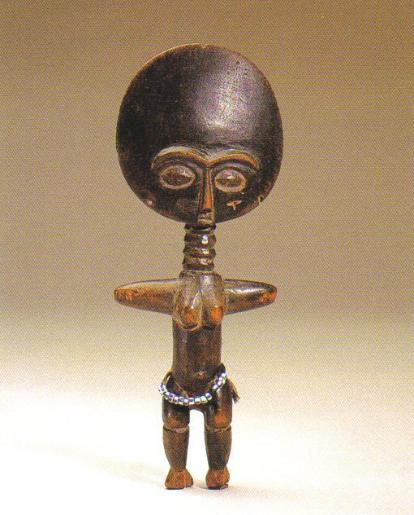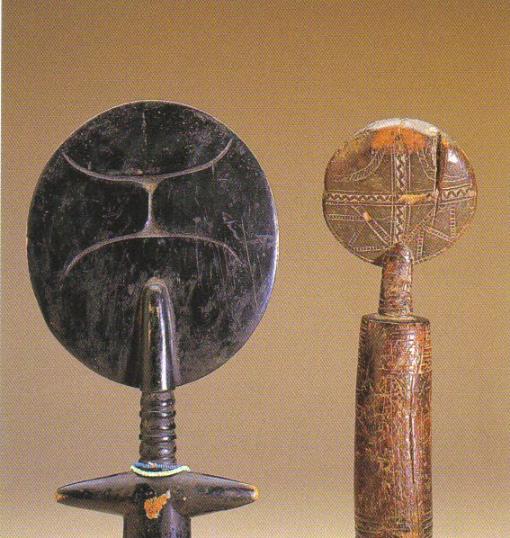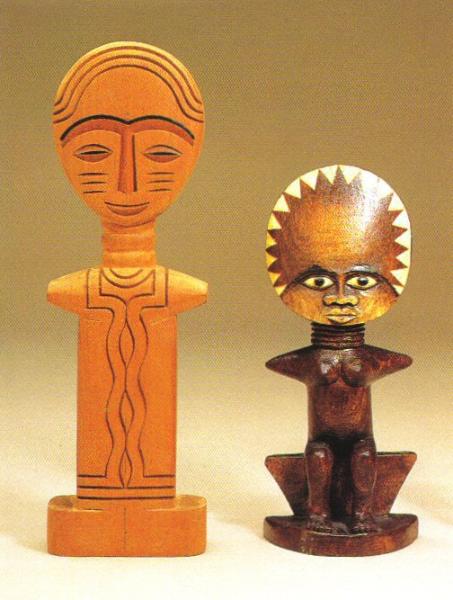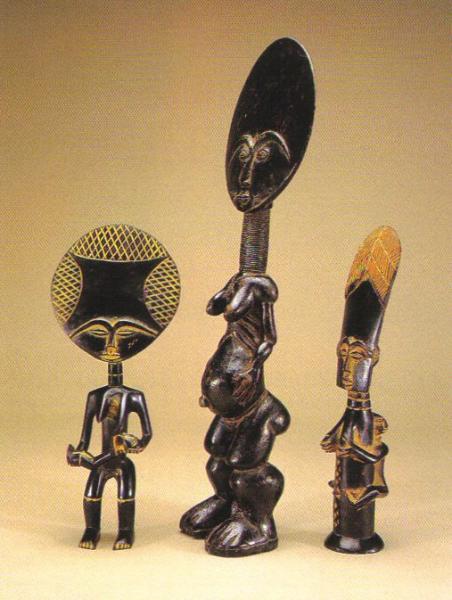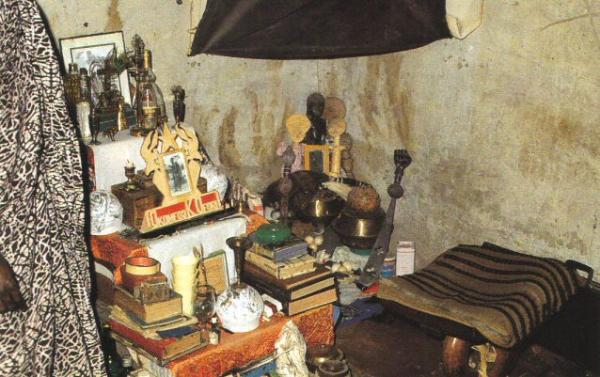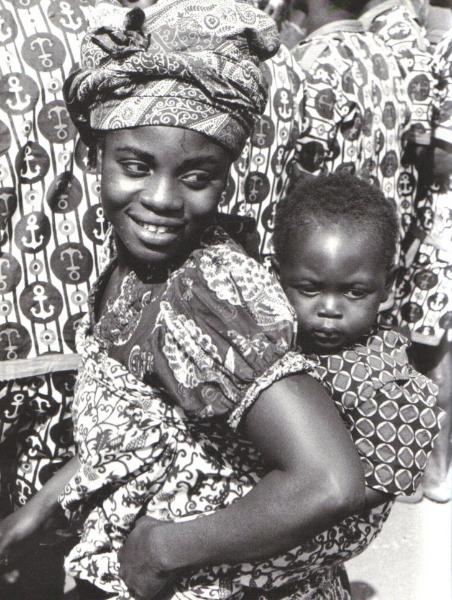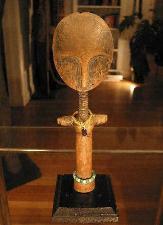
| AKUA'S CHILD AND OTHER RELATIVES: NEW MYTHOLOGIES FOR OLD DOLLS by DORAN H. ROSS |
| The article is below all of the photographs |
| Information and photos below are from the FANTASTIC reference book: ISN'T S/HE A DOLL : Play and Ritual in African Sculpture |
| Fig 57 Akua'ba carved by Osei Bonsu, Kumasi, ca. 1935. Asante peoples, Ghana Wood, pigment 26 cm Private collection |
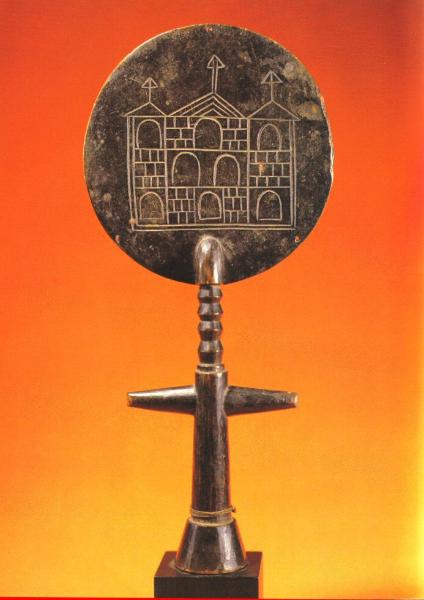
| Fig 48 Akua'mma, Asante peoples, Ghana Wood, beads, pigment Taller 36.6 cm Left: Collection of Mr. and Mrs. Ernie Wolfe I Right: Collection of W. and U. Horstmann |
| Fig 49 Akua'ba with the facade of a Christian church incised into the back of it's head Asante peoples, Ghana wood - 28cm Private collection |
| Fig 60 Akua'ba (front and back views), Asante peoples, Ghana Wood, glass beads, string 37.4 cm National Museum of African Art, Smithsonian Institution, Washington, D.C. |
| Fig 51 Akua'ba, Asante peoples, Ghana Wood, glass beads, string, pigment 23 cm Collection of John B. Ross |
| Fig 44 Akua'mma (sing, akua'ba), Asante peoples, Ghana Wood, glass beads, string Taller 42 cm Private collection |
| Fig 50 Akua'mma, Asante peoples, Ghana Wood, pigment Taller 26.5 cm UCLA Fowler Museum |
| Fig 52 Back views of the figures |

| Fig 56 Akua'ba, Fante peoples, Ghana Wood, pigment 36.8 cm Private collection |
| Fig 54 Akua'mma, Fante peoples, Ghana Wood, glass beads, leather Tallest 32 cm Left: Collection of W. and U. Horstmann Center. The Schorr Family Collection Right: FMCH X65.1526. Gift of the Wellcome Trust (UCLA Fowler Museum) |
| Fig 55 Akua'mma, Brong peoples, Ghana Wood, beads, metal, pigment Tallest 24 cm UCLA Fowler Museum |
| Examples below of contemporary Akua'ba dolls |
| Fig 66 Akua'mma from Suriname (left) and Zimbabwe (right). Wood, pigment Taller 25.7 cm Leff:FMCHX83.515 Flight: Private collection |
| Fig 67 Akua'mma with their own children, carved in Ahwia, Ghana, 1994-95. Wood, beads, pigment Tallest 61.3 cm Private collection |
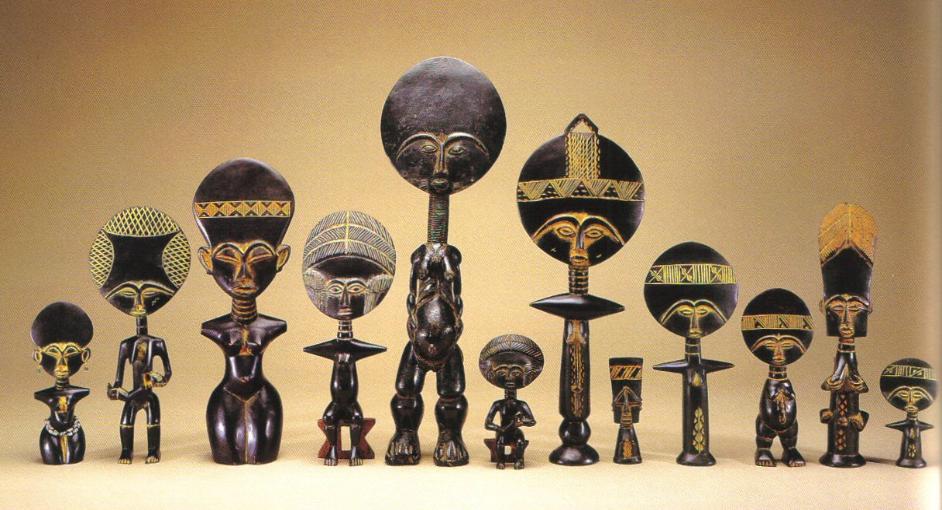
| Fig 68 Akua'mma carved in Ahwia, Ghana, 1992-95. Wood, beads, pigment Tallest 61.3 cm Private collection |
| Fig 69 Fake akua'mma Wood, pigment Taller 27.3 cm Left: Carved by Emmanuel Buorh. FMCH X80.479 Right: Carved by Francis Akwasi. FMCH X86.5511 UCLA Fowler Museum |
| Fig 70 Unity Akua'ba, purchased in Ahwia, 1995. Wood, pigment 42.8cm Private collection |


| (Fig 47 above) Asante shrine Photograph by Eva L. Meyerowitz Bodwiasi, Ghana 1936 (Fig 46 right) Asanta Atano shrine Kumasi region, Ghana Photograph 1976 Large shrines such as this one address a host of community issues under the auspices of a resident priest or priestess. Atano deities, deriving their power and identity from the River Tano, are the tutelaries considered responsible for the health and general welfare of the people, their animals, and crops. Ultimate power, however, comes from the high god, Oyama, who is prayed to but is more remote and not represented in the figural sculpture. |
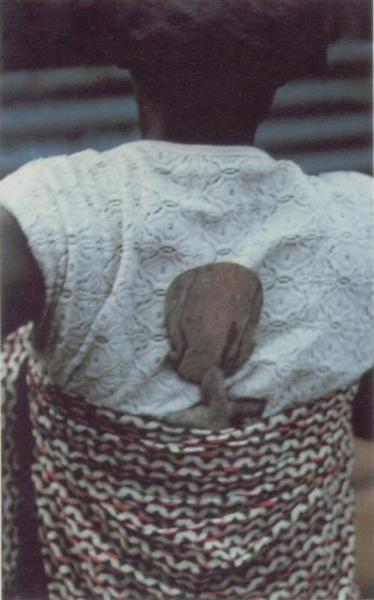
| Fig 53. Religious books, a crucifix, and akua'mma in an Asante shrine. Photograph by Herbert M. Cole, near Kumasi, 1976. |
| Fig 45 An akua'ba tucked into the wrapper of an Asante woman. Photograph by Herbert M. Cole, Ghana, 1972 |
| A Fante mother carrying her child in a wrapper on her back. Photograph by Doran H. Ross Legu, Ghana, 1976 |
| AKUA'S CHILD AND OTHER RELATIVES: NEW MYTHOLOGIES FOROLD DOLLS by DORAN H. ROSS |
| It is one of the more familiar stories in African cultural history. In what is now central Ghana, at some time in the distant past, a young Asante woman named Akua (Wednesday born) was having trouble conceiving a child (ba). To solve the problem she consulted a local priest, who divined that Akua should commission a woodcarving of a little child (Fig. 44). The priest instructed her to treat the carving as if it were a living infant. She was to carry it as all young children are carried, on her back, tucked into her wrapper with just the head appearing above the cloth (Figs. 43, 45). She was told to feed the figure, bathe it, sleep with it, and give it gifts—such as waist beads and beaded earrings and necklaces. |
| When Akua appeared in public with the carving on her back, some in the village pointed and teased, "Oh, look at Akua's child!" But eventually Akua became pregnant and gave birth to a beautiful, healthy little girl. Her success encouraged others struggling with infertility to follow the same path, and all subsequent carvings came to be called akua'ba (pi. akua'mma) in her honor.1 This story has been recorded many times with remarkably little variation. Akua's concerns are the concerns of many young women in Africa, indeed in many parts of the world. Most commonly, it is the desire for children, often many children, that prompts the request for divine intervention. Malcolm McLeod, who has conducted some of the most thorough research on this subject, makes it clear that the ritual process is much more complex than just the commissioning of a carved figure: "The doll would be handed over on the appointed day [to the priest] placed for some time near the god, and then returned to the woman. Probably she would also be given a medicine (aduro) to drink or to bathe in and instructed in certain prohibitions (akyiwadie) to be kept until she had given birth" (1981:165). What happens to the carving after the birth of the child varies widely. In some instances it is returned to the priest who mediated the conception. He displays it on his shrine as evidence of his power and spiritual success (Figs. 46, 47). In other instances it is preserved by the family as an heirloom. Sometimes it might be given to the child as a plaything (Cole & Ross 1977:103-4). There are also reports that if conception is unsuccessful, the woman nevertheless keeps the doll and is buried with it when she dies (Hodinyah 1971:69). Clearly these behaviors are not codified. There is considerable room for individual variation and improvisation. McLeod recorded that akua'mma were occasionally carved even before a woman might encounter problems conceiving a child: It is said that dolls were also bought (or even carved) by fathers or by husbands for daughters or wives. Young (pre-menarche) girls were given these carvings to play with: it was believed that by looking upon a well-formed doll a woman was influenced or assisted to bear a good-looking child. A link of some sort was conceived between the form and quality of the doll and the nature of the child eventually born. (McLeod 1981:166)2 An even more unusual use of an akua'ba figure was noted by Kofi Antubam: In the olden days, whenever a boy or a girl was missing, he or she was believed to have been captured by Mboatia (dwarf spirits), who were the attendants of Sasabonsam (a mythological ubiquitous monster spirit, who was believed to be present everywhere in virgin forests). So whenever such an event took place, a baby's doll was carved, adorned, and placed by a nearby huge tree at the edge of the nearest virgin forest together with some unsalted Eto ko koo (palm-oiled mashed yam), with cooked eggs, and some cowries or silver coins. This was left there for as long as the child remained missing. The belief was that it would attract the Mboatia who were holding the child in captivity. They would come and start eating the food. In their greed, they would prefer a wooden child to the live one who would seek to share their gains with them. And as a result they would set the child free for the Akuaba, and the child would escape home, or be left there to be picked up by its parents. (Antubam 1963:164) The appearance of the Asante akua'ba is as distinctive as the story about it (Fig. 48). Typically it features a disc-shaped head with the face confined to the bottom half or even third of the disc. The mouth is generally positioned at the very bottom, leaving no chin. Eyes shaped like coffee beans or half moons are framed by long, arching eyebrows that connect at the bridge of the nose. Two or three short horizontal or plus-shaped incisions mark the cheeks; these are not signs of ethnic identity but rather representations of medicinal scars employed to protect children from a variety of illnesses. A ringed neck supports the head. Short, cone-shaped arms project at right angles from the upper body, but the figure is usually legless, having instead a base slightly larger in diameter than its cylindrical torso. A few akua'mma have no arms (Fig. 50); even rarer are images that have both arms and legs (Fig. 51). In profile the doll is relatively flat so it conforms to the back of the woman who carries it (Fig. 45).3 The representation of breasts and occasionally genitalia makes it clear that the overwhelming majority of the figures are indeed female. Some informants have said it is simply because Akua's first child was a girl. Others have explained that it is a result of women's desire for female children to help with the workload at home and on the farm. Still others believe that it reflects the Asante system of matrilineal descent. All, of course, could be factors. Regardless, the a/rua'baform is said to represent the Asante ideal of female beauty: a round head with a high, flat forehead (achieved in real life through gentle modeling of the baby's skull), wide cheeks, and a long neck (Hodmyah 1971:69; Cole & Ross 1977:103-7). The backs of the heads of many akua'mma feature incised or low relief carving ranging from the simple to the complex (Fig. 52). Some of this ornamentation references hairstyles, while other designs may have had an apotropaic function. Then again, some patterns are just decorative. One stunning example features the facade of a Christian church (Fig. 49). Although the reverse is seldom true, indigenous Akan belief systems have had little trouble embracing elements of foreign religions, as is evident in the large number of shrines that display both akua'mma and crucifixes, often with European-style dolls (Fig. 53). Although best known, the Asante akua'ba is only one version of the fertility doll found among the various Akan peoples. Fante forms from the coastal regions of Ghana display a long rectangular head and only rarely have arms (Fig. 54). While most Asante figures are painted black, Fante figures are left unpainted. The Brong living to the west of the Asante carve akua'mma with cylindrical heads cut diagonally from the top back to the bottom front, producing a triangle in profile, although some examples deviate from this form (Fig. 55). Generally the undecorated cylindrical torso is rounded on top and limbless.4 There are a number of variations on the conventional forms described above, as can be seen in the Asante shrines in Figures 46, 47, and 53. Among the Brong, Dennis Warren documented several naturalistic shrine figures with arms and legs that were identified as akua'ba. Two of them appear to represent priests, and one depicts a fully clothed woman with a handbag (1976: fig. 6, nos. 3, 14, 22). Warren also documented and photographed a three-foot-high carving clearly in the form of a Brong akua'ba: "Aberewa Agyenna, a large fertility carving in the Akuaba style, is deified and possesses its priest when carried. It also assists barren women to become pregnant" (1976:34). Other large akua'mma, like the example in Figure 56, may never have been carried by either a woman or a priest, and probably served only within the context of a shrine. Images of akua'mma adorning combs, heddle pulleys, staffs, and other object types further expand the range of the genre and presumably its associations with fertility and the growth of the family. Variations aside, it is still the familiar disc-headed Asante akua'ba that defines the style. Along with the Bamana chi wara, Kongo nkisi, and one or two other genres, it is among the best-known images in African art. Indeed, as the quintessential "fertility doll," the Asante akua'ba has become one of the cliches of African expressive culture, and in some instances it has provided a logo for all of African art. As early as 1924, a miniature doll in the style of Asante carver Osei Bonsu (see Ross 1984) was mass-produced in cast metal as a souvenir of the Gold Coast pavilion of the British Empire Exhibition at Wembley (Figs. 57, 58, left).5 In the 1980s the Metropolitan Museum of Art produced a miniature replica of one of their carvings as a gold pendant, and a similar pendant was marketed by ALVA Reproductions (Fig. 58, right). An image of an akua'ba was used as a symbol for the National Museum of African Art by the company City Stickers in a "passport" full of stamps to record "What I've Seen in Washington, D.C." Not to be outdone, the Smithsonian Institution prominently displayed a six-foot-high representation of the same doll (Fig. 60) covered with shiny black seaweed on its 150th anniversary float in the 1996 Rose Parade in Pasadena, whose theme that year was "Kids, Laughter and Dreams" (Figs. 59, 61). Ghana has also promoted the image, using it in a series of postage stamps labeled "fertility dolls" (Fig. 62). One of them serves as signage for the downtown post office in Accra (Fig. 63). What accounts for the popularity of this now very stereotypic form? Many factors, certainly. There is the basic aesthetic appeal of the image. There is also the endearing story of its genesis. That it is a well-established symbol of African female beauty and fecundity is an obvious factor. Another is the popularity of dolls as collectors' items, boosted by the enormous numbers of akua'ba produced and their general availability. McLeod has suggested that until "comparatively recently perhaps one woman in three or four possessed an akua'ba at some stage in her life" (1981:164). His statistics on the availability of akua'mma from Kumasi dealers are telling: "In 1968 an English dealer bought as a single lot over 7,000 such dolls from an African trader based in Kumase. In 1972 during a four-week period 200 such carvings were counted in the possession of a single middle-rank Kumase dealer, and in 1978 about 2,500 dolls, collected over six months, were seen with another Kumase dealer." The ubiquitous presence of the figure clearly promoted thinking about it. Although the concept of akua'ba as "fertility doll" was traditionally associated with facilitating the conception of a child, this idea has been expanded both commercially and conceptually to include a much larger universe. In the work of several late-twentieth-century Ghanaian artists, the akua'ba genre seems to encompass associations ranging from creative and intellectual fertility (one of the Muses?) to some kind of generalized earth goddess. A foreshadowing of this expansion of conceptual associations is found in Vincent Kofi's (1923-1974) well-known but undated (before 1964) bronze Awakening Africa, reproduced in two of the earliest popular volumes on contemporary African art (Beier 1968:54; Mount 1973:131). This female figure reclining back on her elbows has the distinctive cylindrical torso, ringed neck, and disc-shaped head of an akua'ba. Here it is equated with the African independence movements and nation building. The desire for children has become the hope for the growth and empowerment of Africa. Several contemporary Ghanaian artists repeatedly include the image in their work. Some, like Kofi Setordji (b.1957), employ it in something close to its original meaning. Setordji features two Asante-style figures, male and female, in the paintings Procreation (1988) and Wedding Ring (1990), whose titles suggest the child-bearing role of the couple (Fig. 64). The ceramist Kwame Amoah (b.1943) has executed two series that explore the theme—one explicitly called the "Akuaba pot series" and the other the "Family pot series" (Fosu 1993:204, 205). The former is based on Asante domestic wares, while the latter borrows from ritual pots used for rites to maintain the matrilineage. Examples from both series display conventional Asante akua'ba figures projecting from their sides, as if supporting or protecting the vessels in addition to decorating them (Fig. 65). The artist known as Wiz (b. 1957) also includes the figure in his acrylic paintings such as Rare Ancestry (1993), dominated by a nearly three-foot-high akua'ba, and Totem to Matriarchy (1994), where the image's characteristic sweetness is negated by an assertive, almost aggressive, expression. Use of the image is not restricted to Ghanaian artists. For the acclaimed Ethiopian painter Zerihun Yetmgeta (b. 1941), it is a recurring motif. According to Elisabeth Biasio (forthcoming), "Often he uses the nimba mask of the Baga (Guinea) or the Asante akua'ba figure (Ghana), both of which are related to fertility traditions. These motifs are important to the artist because of the famines in Africa." It is not just the "fine art" traditions of Africa that have exploited the image of the akua'ba. Most of the tourist markets in major cities as far apart as Dakar, Nairobi, and Johannesburg display locally produced versions of the fertility figure. That it is so instantly recognizable as African has undoubtedly enhanced its popularity as a souvenir. Targeting this market, the Zimbabwean woodcarver Lancelot Menara, for example, produced fully realistic busts of well-to-do men in coats and ties and women in fancy dresses, and nightclub scenes of musicians and dancers. According to Christa Wilson, Menara's representative at the Limited Edition Gallery in Harare, works with this subject matter did not sell particularly well, so in 1993 she suggested that he turn his attention to producing akua'mma. Examples like the carving in Figure 66 (right) have been moving at a brisk pace. The increasingly international identity of akua'mma was revealingly recorded by Christopher Steiner. He documented Asante-style akua'mma inlaid with beads, based on a design originating in Dakar but carved and sold by Senegalese traders working in Abidjan, Cote d'lvoire. Despite the Ghana/Cote d'lvoire/ Senegal nexus, they refer to these sculptures as poupees Kenya. "The name, according to the traders, refers to the Pan African qualities which the objects represent. They are not marketed as representations of Asante art—they are simply marketed as 'things from Africa' " (Steiner 1994:172, n. 36). Much farther away, Akan retentions among the African-American peoples of Suriname have been much discussed, but such connections have been generally discredited by Sally and Richard Price (1978). The locally carved Asante-style akua'mma on sale at the National Museum of Suriname in Paramaribo are certainly not expressions of any artistic retention. When the Fowler Museum began work on the project Afro-American Arts of the Suriname Plain Forest in 1978, Assistant Director George Ellis presented a copy of The Arts of Ghana to the Director of the Suriname museum, Jim Douglas, as an example of exhibition catalogues produced by the Fowler. Douglas used illustrations from the book to commission figures for sale at his own museum (Fig. 66, left). The carvings were created in different sizes to constitute whole families of figures, which according to Douglas "sold like hotcakes" in the 1980s. Akua'ba figures that have proliferated in Africa generally follow specific stylistic conventions to maintain the instantly recognizable form. In Ghana, however, production has not been so conservative (Fig. 68). Expanding on the concept of the fertility doll, artists in Ahwia, the principal Asante carving village, have been producing akua'mma that have their own children (Fig. 67).6 These mature female figures with full breasts are depicted as either nursing a young child or carrying one on their backs. Deviating from the idea of an infant girl, they draw on the universally engaging image of a mother taking care of her child.7 Obviously, ideas about fertility can be conveyed by all of these variations. One extreme version of the form has three heads (Fig. 70); the seller called it Unity Akua'ba, "because three heads are better than one." In addition to changes in form, there have also been dramatic variations in the size and materials used. As with many tourist arts based on traditional models, when akua'mma are produced as souvenirs they are often increased in size or, alternatively, miniaturized. Instead of wood, akua'mma for the tourist trade have also been produced in brass, ivory, stone, and cloth. Given its popularity, it is no surprise that the akua'ba is among the most widely faked genres of African art (Fig. 69; Ross & Reichert 1983). By this I mean that large numbers of the figures are intentionally made to look old to deceive the potential buyer. Dealers, collectors, and scholars have been consistently fooled by the best of these carvings, which are much more accomplished works of art than most of the better antique examples. Rigid oppositions of real/fake, traditional/modern, and old/new are as problematic as the distinction between a doll and a ritual object in Africa. Most collectors would label the majority of the carvings in Figures 46 and 47 as fake, even though when photographed all were active parts of a working shrine. Competing with the fakes are the staggering numbers of akua'mma carved as tourist souvenirs with no pretensions to being anything other than contemporary versions of a long line of female fertility figures. It is intriguing to contemplate the similarities between the collectors who firmly believe that their akua'mma are authentic and valuable works of art, the tourists who firmly believe that the carvings will help them connect with the motherland, and the hopeful young Asante women who firmly believe that the fertility dolls will allow them to become pregnant. If believing makes it so, then everyone lives happily ever after. In all cases, belief overcomes any consideration of deception, and it is belief that sustains and encourages collector, tourist, and aspiring mother. And it is these same beliefs that have stimulated the proliferation of the genre and the variations within it. In the United States the akua'ba has also grown in stature and expanded in narrative. Some of the currently popular ideas about the image are rooted in long-discredited scholarship. Arguments that the Asante akua'ba is derived from the ancient Egyptian ankh (Fig. 71), the so-called cross of life (Segy 1963), have been revived in recent years. In the complete absence of evidence that bridges the temporal and geographic gap between ancient Egypt and the Akan of the past two hundred years, the arguments must be dismissed as implausible. That said, it is equally clear that the Egyptian connection has been embraced by many in the African- American communities of the United States and has become part of the popular oral and written traditions about the akua'ba recounted in numerous commercial and ritual contexts. What was once considered unconvincing scholarship is being increasingly codified as a new tenet of belief. Similarly, the Fante artist and scholar Kofi Antubam wrote that the round-headed akua'mma were female and those with rectangular heads were male (1963:163). This assertion was probably based on the fact that the disc-headed Asante forms frequently depict female breasts and genitalia, but the rectangular-headed Fante carvings rarely do. Antubam suggested that the shape selected by the parents indicated which gender they preferred for the child. This too has become part of the contemporary folklore for akua'mma in the United States. Abenyega Adedze, a Ghanaian graduate student at UCLA, told me how, in 1995, an African-American couple in Los Angeles who were shortly to be married asked him for advice on the use of akua'mma in a traditional African wedding ceremony. Adedze explained that akua'mma were not used on this occasion in Ghana. Nevertheless, the couple decided to use a contemporary version of the fertility figure as a centerpiece on each table at their wedding reception, hoping to encourage the conception of their first child. The distinction between the scholarly view and the popular one is, of course, important. Is it a doll or isn't it? Is there a connection with Egypt? Does it work? On some of these issues, academic opinion is out of step with popular belief. But with whom does the outside observer side? I would argue, for better or worse, that the believers win here. Regrettably, academia (which includes my own pretensions) all too often passes on the narrow and distant traditions while the believers pass on the larger and more diverse traditions. And the newest traditions. If more scholars studied present rather than past beliefs about akua'mma, then ideas about the dolls would be framed and presented differently. It is likely that the histories of many types of African art are as dynamic as that of the Asante fertility doll called akua'ba. It is a profound disappointment that we don't know more about them. NOTES 1. McLeod, citing J. G. Christaller's Dictionary of the Asante and Fante Language Called Tschi (Twi), notes an alternative meaning for akua as "a human figure in clay" used in funeral rites and suggests that akua'ba might be a diminutive of akua (McLeod 1981: 166). Although akua'ba has become the generic name for these figures, individual examples are often given their own names, such as the akua'ba called Afua Fofie photographed and documented by Dennis Warren (1976: fig. 7). 2. The cover (and opp. p. 20) of Peter Sarpong's book Girls' Nubility Rites in Ashanti features a headload of gifts to the initiate's house. Surmounting the gifts is an akua'ba. Regrettably, Sarpong does not elaborate, so it is not clear if this was a unique improvised occur¬rence or a regular part of the ceremony. 3. A provocative detail in one of the folktales recorded by R.S. Rattray tells of a childless woman who used a wooden spoon with attached beads as a surrogate child (1930:269). It is tempting to speculate that the first akua'mma were based on the form of a traditional Akan spoon with a pestle as a handle. 4. Among the non-Akan Degha living northwest of the Asante, Rene Bravmann documented a "surrogate figure" called Kayere or Akua-ba, which the Degha admitted borrowing from the Asante. According to Bravmann, "The Kayere occupies the same roles among the Degha as does the Akua-ba among the Ashanti, although it may be used as an altar figure for female protective shrines (1970:42; see also Bravmann 1973:17). 5. I would like to thank Mr. P.M. Kent for bringing this relationship to my attention. 6. See Cole & Boss (1977:108, fig. 218) for a rare example of an older akua'ba-style figure with a child. 7. Some of the new oral traditions about akua'mma are borrowed from the promotional literature used to market the figures. For example, in the booklet Handicrafts Ghana, published by the Ghana Export Promotion Council, a contemporary variation of the form is labeled "A seated fertility doll breast feeding her baby. This symbol signifies the love and responsibility a mother owes her child" (1989:36). |
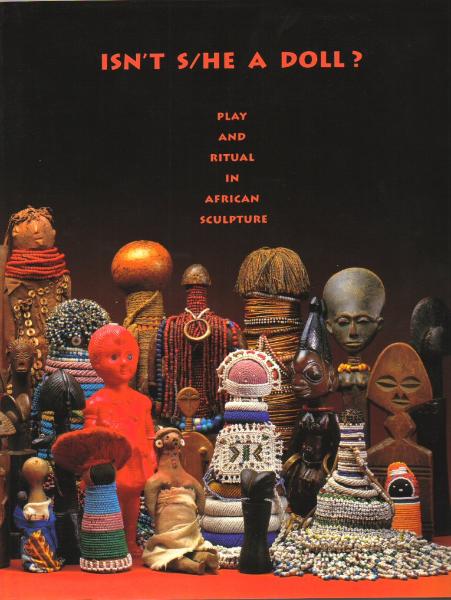
| A book that I highly recommend for anyone interested in the use of dolls in various African cultures. |
| Rand African Art home page Educational Resources page |
| Click below to see the Akua'ba dolls in my collection Asante art main page |


